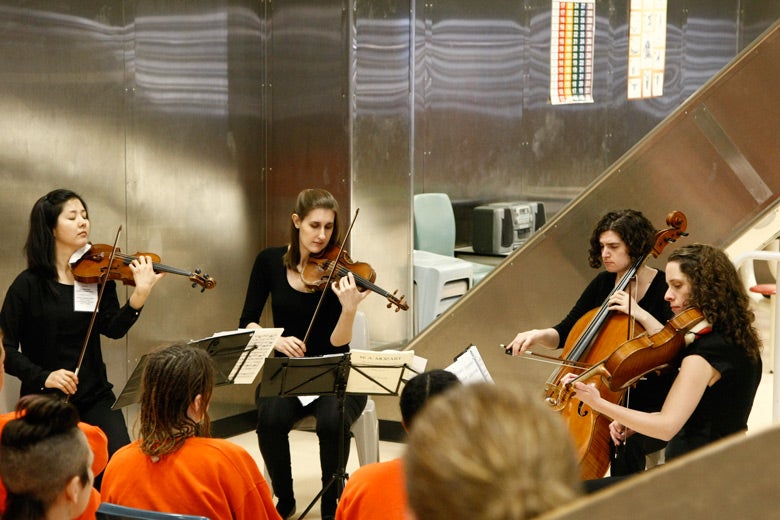
The Cecilia String Quartet performs for an audience of incarcerated women at the San Francisco County women’s jail. (Image credit: Courtesy San Francisco County Jail)
The silver metal walls of the cavernous industrial gymnasium reflected orange-clad women, staff members and corrections officers who came together to hear the Cecilia String Quartet perform Mendelssohn’s Opus 44, No. 2. Any nervousness the musicians felt going through the security check transformed into energy, encouraged by more than 60 incarcerated women at the San Francisco County women’s jail who listened intently in concentrated silence.
The performance, which took place earlier this spring, exemplifies the type of community outreach spearheaded by Stanford’s ensemble-in-residence, the St. Lawrence String Quartet, through the Emerging String Quartet Program. The performers’ openness, sense of humor and obvious passion for the music made it easy for the musicians and audience to connect. During the question-and-answer period following the performance, inmates expressed appreciation for both the classical and modern pieces, the latter in the form of the second movement of Serbian Canadian composer Katarina Curcin’s Walking Away From, which inspired particular interest in the cello. Leaning forward in her chair, one inmate said, “I can see the love you feel playing.”
Debbie Mukamal of the Stanford Criminal Justice Center, who connected Stanford’s Department of Music with the San Francisco County jail, emphasizes the unique aspects of the facility.
“The programming available to men and women incarcerated at the San Francisco jail is unusually extensive,” Mukamal said. “Leadership at the facility has championed the availability of educational, health and other types of programs that improve daily conditions, expose those incarcerated to positive experiences and decrease their likelihood of returning to crime.”
The Emerging String Quartet Program (ESQP) has been a work in progress as the St. Lawrence String Quartet (SLSQ) seeks to recreate community outreach opportunities they were exposed to in their early years together. Violinist Geoff Nuttall explains, “For about 10 years in New York we were encouraged to perform for all sorts of audiences we would never have encountered otherwise. We want to replicate that experience for the next generation.” Visiting artists work closely with the SLSQ, who coach them both musically and as communicators. The range of audiences requires a variety of approaches, sometime beginning with the basics of how stringed instruments are built. Nuttall laughs, “It’s not enough to study with accomplished old people. As artists we have to reach out.”
Performance challenges and rewards
Through the ESQP, musicians who show both excellence in performance and an interest in developing their own outreach programs are invited to Stanford for a week of intensive performance for underserved audiences or in nontraditional venues. The fall quarter guest ensemble, Excelsa Quartet, had an equally rewarding experience performing in an Azure Family Concert, a series tailored for families with children and young adults on the autism spectrum.
The concert series began experimentally two summers ago in collaboration with jazz and classical pianist Stephen Prutsman. Prutsman, founder of Autism Fun Bay Area and father to a 13-year-old son with autism, wanted to create events where families with autistic children could enjoy world-class music.
“One of the biggest challenges our families face is how to participate in events that are primarily for the neurotypical. Many autistic persons have uncontrollable vocalizations and a difficult time sitting still. The Azure concerts allow and embrace distinctive behaviors. Families can relax, not worry about being asked to leave because of these different behaviors, and the children have opportunities to socially engage with the performers,” Prutsman explained.
Kacy Clopton, cellist of the Excelsa Quartet, described the Azure concert as “an extraordinary experience. It was deeply moving to see how the music affected each child quite differently. One little girl was so thrilled to feel the vibration of the cello, she was grinning from ear to ear. A young boy, perhaps 11 years old, seemed most affected by using the bow and seeing how the strings would spring into action when he plucked them. Maybe the best aspect for me personally was seeing how happy the parents were to be able to share this experience with their child. The music could soothe their active minds in a way that nothing else can.”
The ESQP began with a generous seed grant from the Hewlett Foundation, and is now supported on a year-to-year basis through grants and individual donations, allowing the SLSQ to send quartets to more than 40 venues, including community groups such as the VA Palo Alto Health Care System and the California School for the Blind. If you would like the ESQP to visit your school or organization, email SLSQsu@gmail.com.